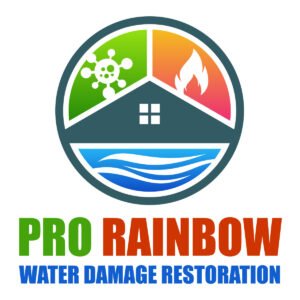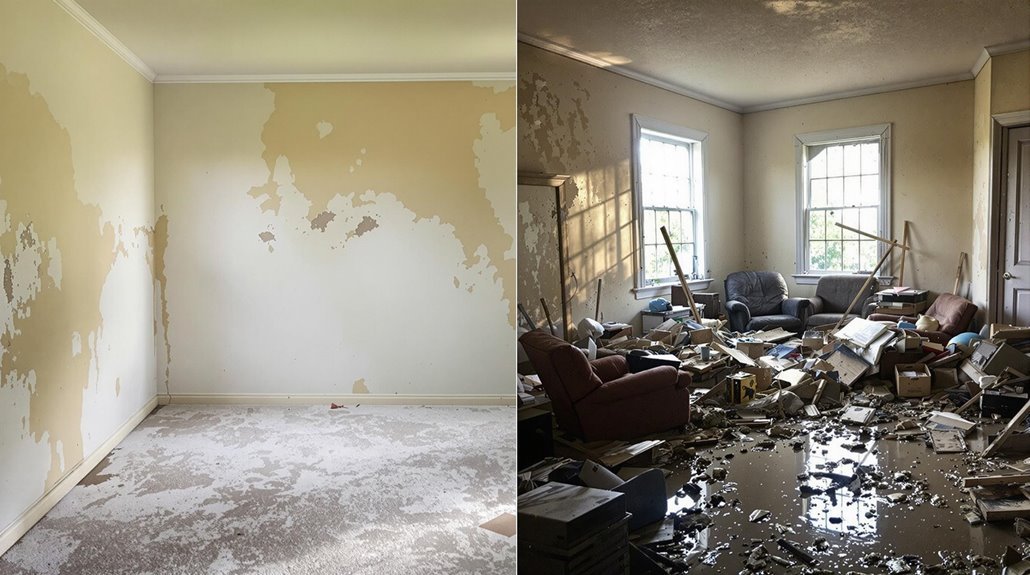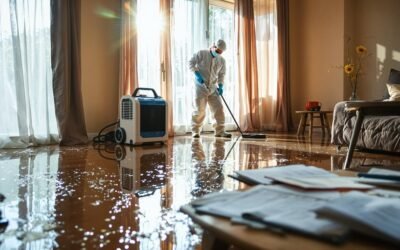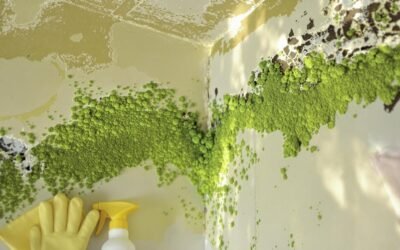Water damage arises from internal sources like leaky pipes or malfunctioning appliances. These incidents cause deterioration within your property. On the other hand, flood damage stems from external factors such as heavy rainfall or storm surges that overflow onto dry land. While standard homeowners insurance often covers water damage, flood damage usually requires a separate flood insurance policy. Quick assessment and repairs are essential for both scenarios to minimize long-term effects, including mold growth and structural damage. Knowing the distinctions helps you act appropriately. To further understand prevention and restoration methods, continue exploring the complexities of these issues.
Key Takeaways
- Water damage results from internal leaks or appliance malfunctions, while flood damage comes from external water overflowing onto dry land.
- Standard homeowners insurance typically covers water damage, but flood damage requires separate flood insurance policies for adequate protection.
- Water damage can often be prevented with regular maintenance and quick repairs, whereas flood damage requires proactive measures like drainage systems and emergency plans.
- Restoration for water damage focuses on drying affected areas and preventing mold, while flood restoration involves water removal and thorough inspections post-damage.
- Understanding the causes and differences helps in better emergency preparedness and effective response strategies for both water and flood damage.
Definition of Water Damage

Water damage refers to the unintended destruction or deterioration of materials and structures caused by the presence of water. Various water sources, such as leaks, overflowing appliances, or even condensation, can lead to this type of damage. To effectively address water damage, conducting a thorough damage assessment is vital. During this assessment, you'll identify the extent of the damage, the materials affected, and the potential hazards involved. Understanding the origin of the water and its impact on your property allows you to take appropriate action, whether it's drying out a space or replacing damaged materials. Prompt and accurate damage assessment can greatly reduce repair costs and prevent further complications, ensuring your property remains safe and structurally sound. Additionally, professional restoration services can prevent mold growth through thorough moisture removal, further safeguarding your property.
Definition of Flood Damage
Flood damage refers to the destruction caused by water overflowing onto land that is normally dry, often because of heavy rainfall, storm surges, or dam failures. Understanding the causes of flood damage is essential, as it can greatly impact property value and safety. You'll want to assess the extent of the damage to determine necessary repairs and preventive measures. Additionally, addressing water damage restoration quickly can help minimize long-term effects on your property.
Causes of Flood Damage
When heavy rainfall or rapid snowmelt occurs, the risk of flood damage considerably increases. Factors such as poor drainage systems, urban development, and land erosion can worsen flooding. Furthermore, inadequate flood prevention measures, like levees and barriers, may fail during extreme weather events. Flash floods can arise suddenly, catching you off guard and causing significant damage. Understanding these causes is crucial for effective damage assessment, as it helps you identify vulnerable areas and implement preventive strategies. Seasonal changes and climate variations likewise contribute to the likelihood of flooding. By recognizing these causes, you can better prepare and mitigate potential flood damage, ensuring your property remains protected against nature's unpredictability.
Impact on Property
The devastation caused by flood damage can greatly impact property, leading to both immediate and long-term consequences. When evaluating damage, you'll need to examine structural integrity, electrical systems, and personal belongings. This damage evaluation is essential for determining the extent of repairs needed and understanding the financial implications. Flooding may markedly lower property valuation, as potential buyers often perceive flood-prone areas as risky investments. Furthermore, if your property isn't adequately insured, you might face substantial out-of-pocket expenses for repairs. Addressing flood damage promptly not only mitigates further deterioration but likewise helps maintain your property's market value. Ultimately, understanding these impacts can guide you in making educated choices about repairs and insurance coverage.
Common Causes of Water Damage
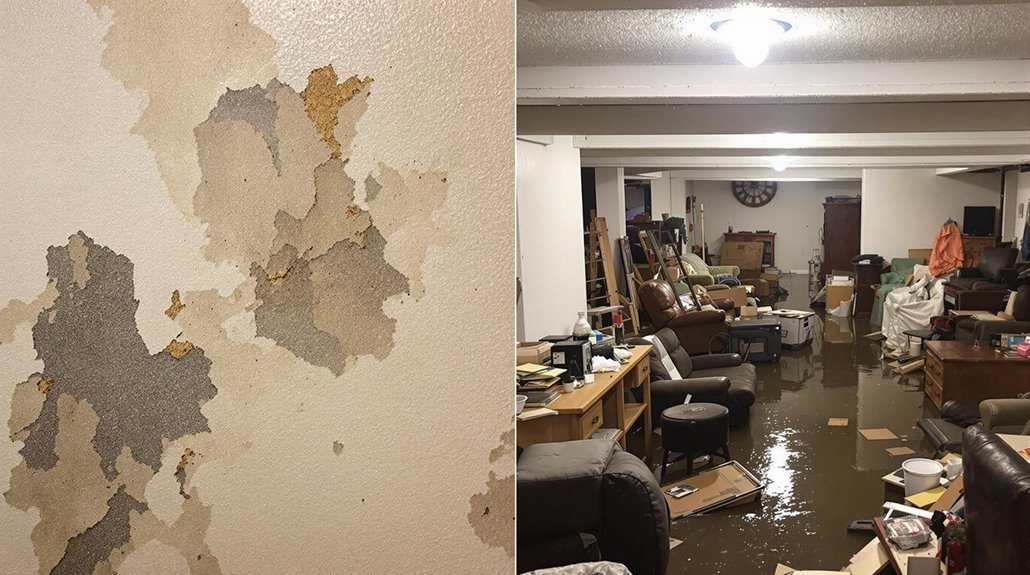
Water damage can stem from a variety of sources, with some of the most common being burst pipes, appliance malfunctions, and roof leaks. Understanding these causes is essential for effective leak detection and moisture control.
| Cause | Description | Prevention Tips |
|---|---|---|
| Burst Pipes | High pressure can cause pipes to rupture. | Regular inspections and repairs. |
| Appliance Malfunctions | Dishwashers and washing machines may leak. | Maintain appliances regularly. |
| Roof Leaks | Damaged shingles can lead to water intrusion. | Inspect and repair roofs annually. |
Common Causes of Flood Damage
Flood damage often stems from several key factors that can greatly impact your property. Heavy rainfall events can overwhelm drainage systems, while storm surges can push ocean water inland, causing extensive damage. Furthermore, river overflow incidents can lead to catastrophic flooding, especially in low-lying areas.
Heavy Rainfall Events
Heavy rainfall events can lead to significant flood damage, often overwhelming drainage systems and saturating the ground. When rainfall intensity exceeds the capacity of these systems, water accumulates rapidly, creating surface runoff. This runoff can erode soil, destabilize structures, and cause water to infiltrate buildings. The heavy rainfall impacts are particularly severe in urban areas, where impervious surfaces prevent natural absorption. Furthermore, prolonged heavy rainfall can lead to riverine flooding, as rivers overflow their banks. Understanding the specific conditions that lead to flooding during heavy rainfall is essential for effective prevention and response strategies. By recognizing the patterns and risks associated with these events, you can better prepare for potential flood damage in your area.
Storm Surges Impact
When a storm surge occurs, it can dramatically raise sea levels, leading to widespread coastal flooding. These storm surge effects often result from hurricanes or severe storms, pushing ocean water inland. As the water inundates coastal areas, it can cause significant property damage and displace residents. Moreover, the force of the surge contributes to coastal erosion, undermining shorelines and destroying habitats. This erosion can have long-term impacts on coastal ecosystems and infrastructure. Understanding the dynamics of storm surges is essential for effective disaster preparedness and response. Homeowners in vulnerable areas should consider flood insurance, as traditional homeowner policies typically don't cover flood damage caused by storm surges, underscoring the importance of awareness.
River Overflow Incidents
Coastal areas aren't the only regions at risk; river overflow incidents can likewise lead to significant flood damage. These incidents often stem from heavy rainfall, rapid snowmelt, or inadequate river management practices. Understanding these causes is crucial for effective emergency preparedness.
| Cause of River Overflow | Impact on Flood Damage |
|---|---|
| Heavy Rainfall | Sudden rise in water levels |
| Rapid Snowmelt | Increased water flow |
| Poor Drainage Systems | Water accumulation |
| Deforestation | Soil erosion, flooding |
| Urban Development | Reduced natural absorption |
Insurance Coverage Differences

While both water damage and flood damage can wreak havoc on your property, the way insurance covers these incidents differs considerably. Typically, standard homeowners insurance policies cover water damage resulting from internal issues, like burst pipes or appliance failures. Nevertheless, flood damage, which is defined as water overflow from natural sources, often requires separate flood insurance policies. These policies usually come with specific coverage limits and may not cover all types of water-related damage. It's essential to review your insurance policies carefully to understand what's included and excluded. If you live in a flood-prone area, investing in extra coverage is wise to guarantee you're adequately protected against potential losses. Always consult your insurance agent for tailored advice.
Restoration Process for Water Damage
As soon as you find water damage in your home, it's crucial to act quickly to mitigate further complications. Start by initiating water extraction to remove standing water and prevent structural damage. Use pumps and vacuums specifically designed for water removal. Once the area is dry, inspect for mold growth, as damp environments encourage mold proliferation. If mold is present, proceed with mold remediation, which involves containment, removal of affected materials, and thorough cleaning. Confirm your home is adequately ventilated and monitor humidity levels to prevent future issues. After addressing these concerns, you can begin repairs and restoration, including replacing damaged materials and repainting surfaces to restore your home to its pre-damage condition.
Restoration Process for Flood Damage
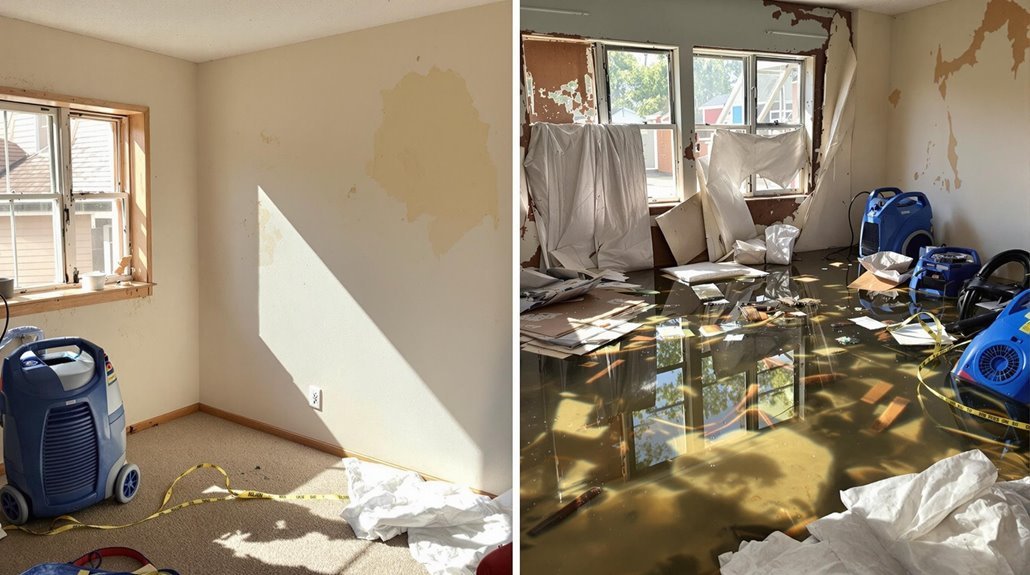
The restoration process for flood damage differs greatly from that of standard water damage due to the extent and nature of the impact. When dealing with flood damage, it's essential to follow specific flood restoration techniques to guarantee safety and effectiveness. Here's a structured approach:
- Emergency Response Planning: Assess the situation, confirm everyone is safe, and contact professionals.
- Water Removal: Use pumps and vacuums to eliminate standing water quickly, minimizing structural damage.
- Drying and Dehumidification: Employ industrial fans and dehumidifiers to dry out affected areas thoroughly, preventing mold growth.
These steps are critical in restoring your property and mitigating long-term damage, securing a safer environment post-flood.
Preventing Water Damage
To prevent water damage, you need to conduct regular maintenance checks on your plumbing and appliances. Addressing any leaks promptly can save you from costly repairs and extensive damage. By staying proactive, you can greatly reduce the risk of water-related issues in your home.
Regular Maintenance Checks
Regular maintenance checks are essential for preventing water damage in your home, especially since small issues can quickly escalate into major problems. By implementing regular inspections and adhering to maintenance schedules, you can effectively reduce risks. Here are three key areas to focus on:
- Roof and Gutters: Inspect for debris and leaks to guarantee proper drainage.
- Plumbing: Check pipes and fixtures for signs of wear or leaks that may lead to significant water damage.
- Basements and Crawl Spaces: Monitor for moisture accumulation and guarantee proper ventilation to prevent mold growth.
Quick Leak Repairs
Conducting regular maintenance checks sets the stage for prompt leak repairs, which are crucial for preventing water damage in your home. Identifying potential issues early allows you to implement quick repair strategies, like using pipe sealants or rubber patches for small leaks. For more significant problems, having emergency leak solutions on hand, such as temporary plumbing clamps or a bucket for drip collection, can mitigate damage until professional help arrives. Remember, addressing leaks swiftly not only saves you money on repairs but furthermore protects your property from mold and structural issues. Regularly inspect areas prone to leaks, like under sinks and around appliances, ensuring you're always prepared to act quickly at the first sign of trouble.
Preventing Flood Damage
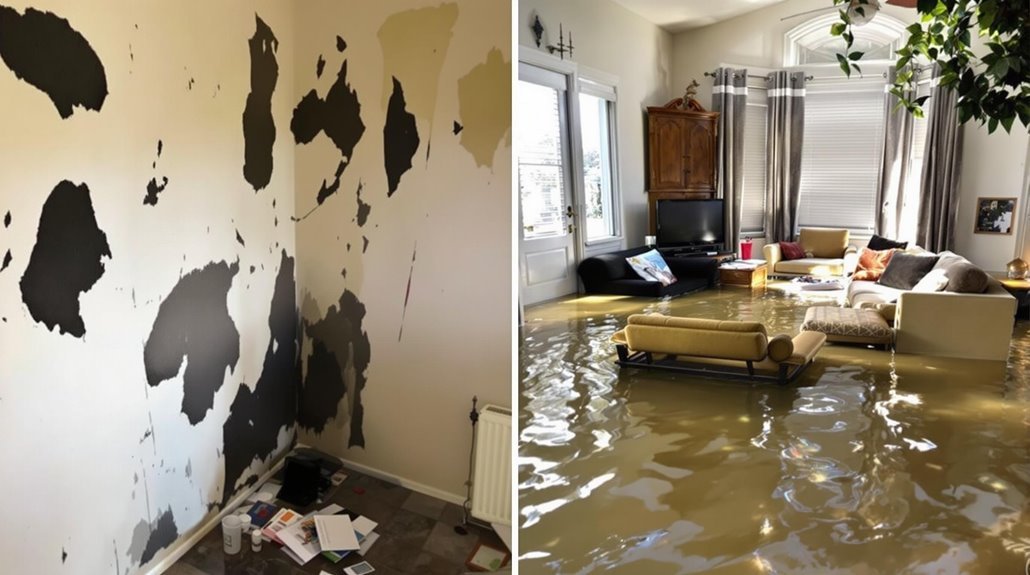
Although floods can be unpredictable, there are several proactive measures you can take to minimize your risk of flood damage. Implementing effective flood preparedness strategies and drainage solutions is vital. Here are three important steps:
- Assess Vulnerabilities: Identify areas around your property that are prone to flooding and address them with appropriate landscaping or barriers.
- Install Drainage Systems: Utilize French drains or sump pumps to redirect water away from your home, effectively managing excess rainwater.
- Create a Flood Plan: Develop an emergency plan for your household, including evacuation routes and an emergency kit, ensuring everyone knows their role during a flood.
Importance of Professional Assessment
When it comes to addressing water damage and flood risks, engaging a professional for assessment is crucial, as their expertise can uncover hidden vulnerabilities that you might overlook. A professional evaluation leverages advanced assessment techniques, ensuring a thorough understanding of the situation. They can identify the source of the water intrusion, evaluate structural integrity, and detect potential mold growth or other hazards. This all-encompassing analysis allows for tailored remediation strategies, minimizing long-term damage and costs. Attempting to assess the damage yourself often leads to incomplete or inaccurate summaries, which can worsen the problem. By relying on professionals, you gain peace of mind, knowing that your property is in capable hands and that all issues are addressed effectively.
Conclusion
In the realm of home maintenance, understanding the difference between water damage and flood damage is like steering through a minefield. One misstep can lead to costly repairs and insurance headaches. By recognizing the unique causes, coverage options, and restoration processes for each, you can safeguard your property effectively. Don't underestimate the importance of professional assessment—dipping your toes into DIY solutions might not always be enough. Stay informed, and make certain your home remains a safe haven.
